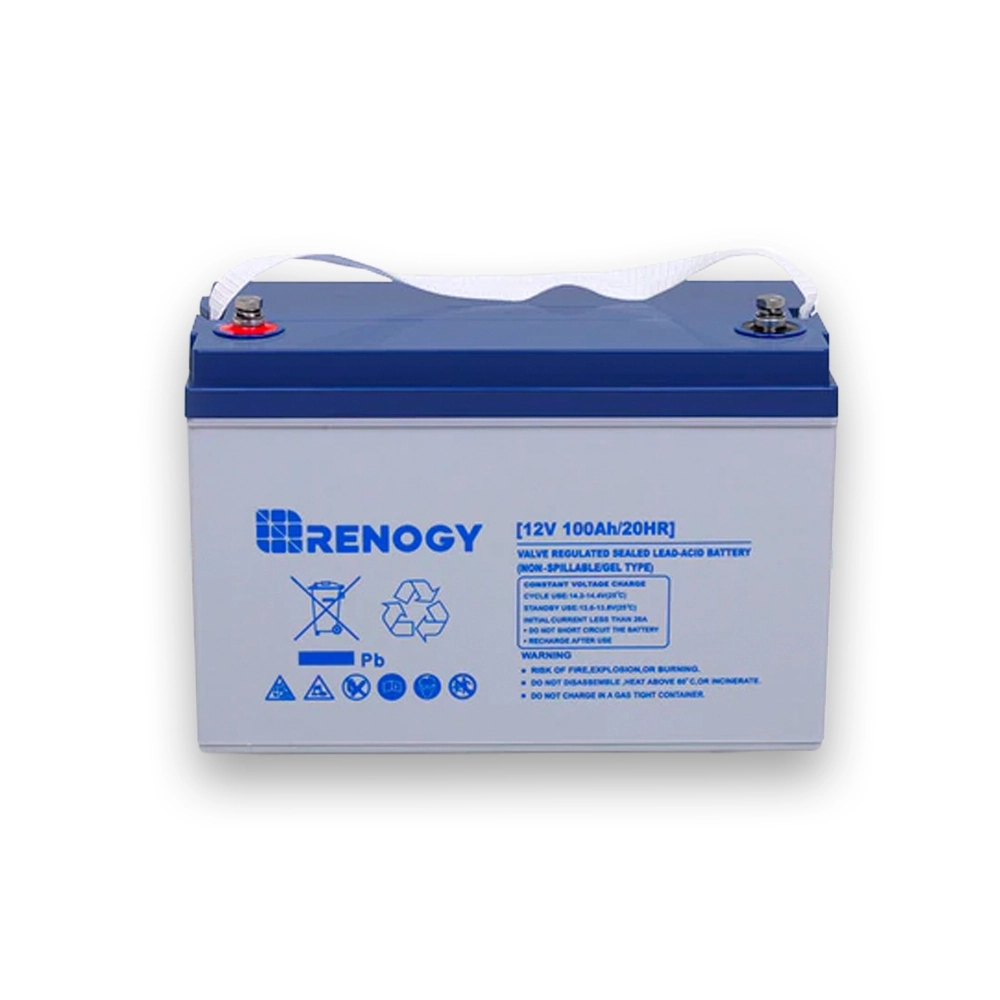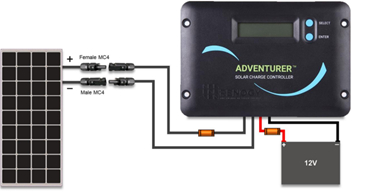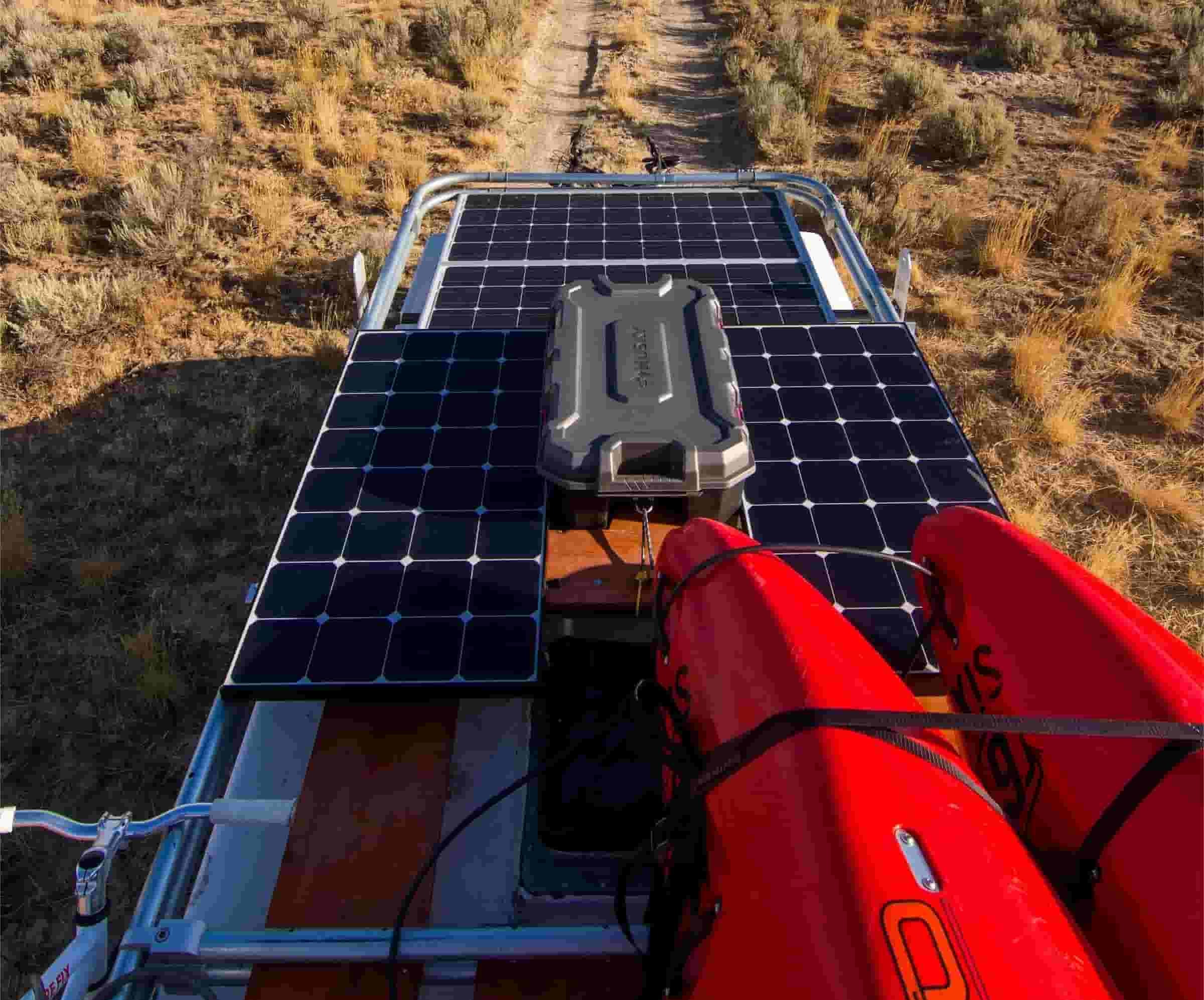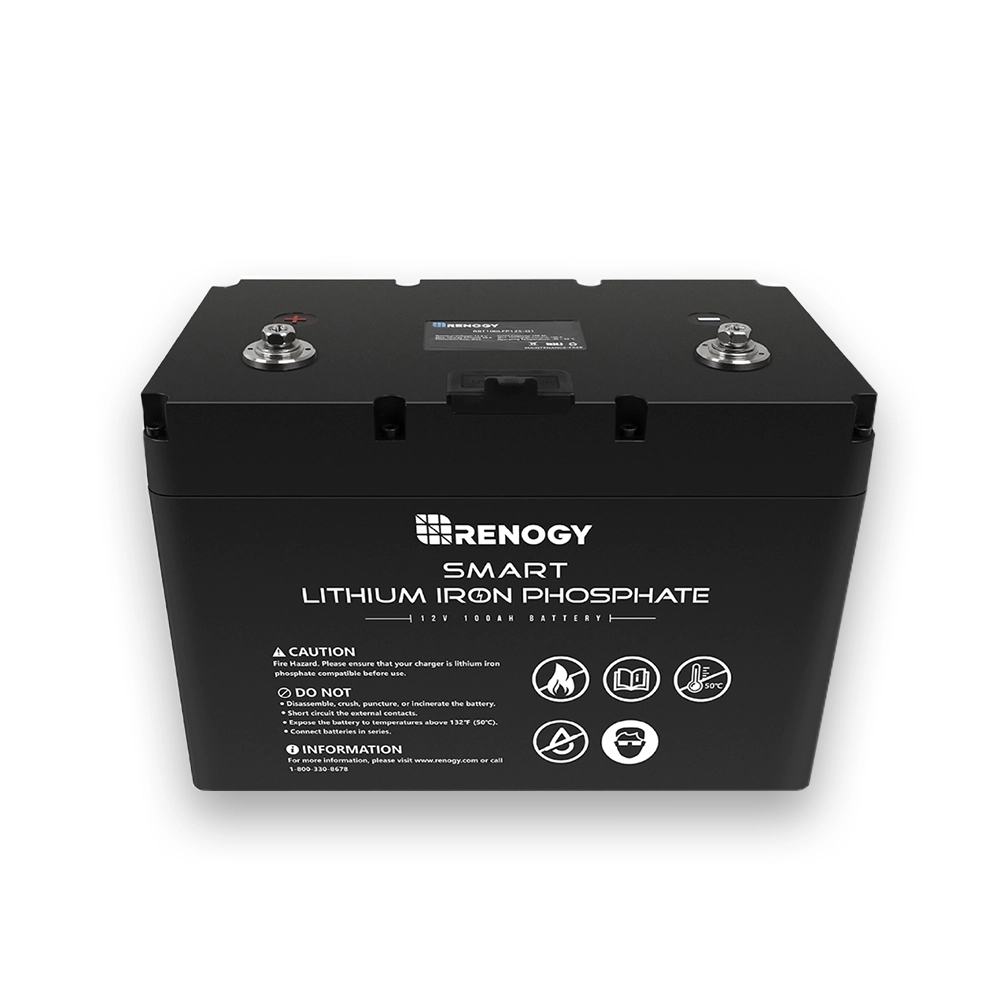What size solar panel do I need to charge a 12v battery?
Authors Note: This has been updated on Feb 9, 2022 with updated information, links, and resources.
What to know about using 6 volt batteries in your solar installation
If you live in an RV, van, or cabin, solar with battery storage is a great way to meet your energy needs. Once you’ve selected your solar panel kit, you’ll need to purchase a battery to store that energy produced from your panels. But how do you make sure that battery gives you the power you need and how do you know that solar panel will charge that battery effectively? Let’s break it down.
What are deep cycle batteries?
Deep cycle batteries may look similar to the batteries used in your car, but they are actually very different. In contrast to car batteries which only provide short bursts of energy, deep cycle batteries are designed to provide sustained energy over a longer period of time. Deep cycle batteries can be discharged up to 80%, but most manufacturers recommend not discharging below 45%. Regularly going beyond that point will shorten the life of the battery.

How do you charge batteries with solar panels?
Using solar panels to charge a battery, you’ll still need a charge controller. The wiring diagram below can offer you an easy understanding.

how to charge a battery from solar panel
Can you charge solar batteries without charge controllers? The answer is necessary and obvious, solar panels with batteries need a charge regulator which will be responsible for maintaining the charge of the batteries and keeping them in good condition. Solar batteries store the energy that is collected from your solar panels. The higher your battery’s capacity, the more solar energy it can store. In order to use batteries as part of your solar installation, you need solar panels, a charge controller, and an inverter.
When using batteries for solar panels as part of a home solar system, you’re able to store the excess electricity your panels produce instead of sending that energy back into the grid. Electricity will be sent to the grid if your batteries are fully charged and your panels are still producing energy.
Your solar panels will first need to be connected to a charge controller which will help monitor how much energy is stored in the batteries to prevent overcharging. Charge controllers will also shut down a system if the batteries become too depleted. Before powering your appliances, your batteries will need to be connected to an inverter to convert the DC energy collected from solar panels and converted to AC energy.
How to charge 12v battery?
In addition to solar panels, you can also charge your 12V battery through grid power and alternators. But the other two ways will not be as economical as solar panels which offer access to clean and free solar power.
What are amp hours?
Deep cycle batteries have a specific amp hour rating. This refers to the amount of current that is supplied from the battery over a certain period of time. If you have a 200ah battery, it can supply 20 continuous amps for 10 hours or 10 amps for over 20 hours.
How many amps does a 100 watt panel produce?
Calculate the current in amps by dividing power in watts by the voltage in volts. When a 12V solar panel is rated at 100W, that is an instantaneous voltage rating. So if all of the test conditions are met, when you measure the output, the voltage will be about 18 volts. Since watts equals volts times amps, amperage will be equal to 5.5 amps (100 watts divided by 18 volts) . So your panel will produce 5.5 amps per hour.
How many panels would I need to charge a 200ah battery?
If you have a 200ah battery, only 80% of that is usable due to depletion limitations, so you really only have 160 amp-hours of energy to draw on. If you learn that you typically can last two days with energy from that battery, that means you consume 80 amp hours a day.
Based on the earlier calculation, a 100 watt panel will produce an average of about 30 amp-hours per day (based on an average sunny day). This means you would need three 100 watt solar panels or one 300 watt panel to fully recharge your battery on the average day.
How long will it take to charge a battery?
Total charging time depends on the weather, as well as state and type of battery. If a battery is completely drained, a panel can typically charge the battery within five to eight hours.
The total charging time will vary depending on the state of a battery. If a battery is totally drained, a solar panel can energize the cells within five to eight hours. The position of the sun in the sky can impact a panel’s charging speed. When sunlight shines directly on a panel in the middle of summer, the charging speed will be faster. Charging cycles are slower on cloudy days.
How many solar panels does it take to charge a 100ah battery?
Again we use the same calculation dividing power in watts by the voltage in volts to find amps. Charging your battery at 12 volts and 20 amps will take five hours to charge a 100 amp hour battery. By multiplying 20 amps by 12 volts, 240 watts is how big of a panel you would need, so we’d recommend using a 300w solar panel or 3 100 watt solar panels.

What are the best conditions to charge a battery?
You’ll find that all of Renogy’s deep cycle batteries have a normal operating temperature, storage temperature, and operating charge temperature specifications listed. Most batteries have a normal operating temperature of 77°F plus or minus 5.4°F. Most batteries have an ideal operating temperature between 50°F and 85°F. Batteries typically lose about 10% of their capacity for every 15°F to 20°F below 80°F. Their internal chemistries slow down, resistance increases and capacity and charge acceptance drop. This reduced capacity is temporary.
Does it matter what kind of battery you use?
Yes! Different batteries can have a huge impact on how your solar installation operates. There are three main types of deep cycle batteries used in solar systems: flooded lead acid, sealed lead acid, and lithium iron phosphate batteries. Each of these batteries vary in price, battery capacity, voltage, and cycle life.
For example, battery capacity is important because it measures the amount of energy you can store. If you need to power certain appliances for long periods of time, you'll need more batteries to carry a bigger load. Capacity is measured in total amp hours. Look at cycle life to learn about the number of discharge and charge cycles a battery can provide before the capacity drops below the rated capacity. This varies sharply from technology to technology and is measured in a number of cycles. For more information about battery types and how to choose the best battery for your system, refer to our blog post.
Do lithium batteries charge faster than flooded lead acid batteries?
Lithium iron phosphate batteries are more efficient than sealed and flooded lead acid batteries. They also have a faster rate of charge. This is because they can typically handle a higher amperage, which means they can be recharged much faster than flooded lead acid batteries. Lead-acid batteries are limited in how much charge current they can handle, mainly because they will overheat if you charge them too quickly. In addition, the charge rate gets significantly slower as you approach full capacity.
How do I size my battery bank and why is it important?
It’s very important to properly size your deep cycle battery bank. The amount of battery storage you need is based on your energy usage. Energy usage is measured in kilowatt hours. For example, if you need 500 watts for 8 hours per day, then your energy usage is 4kWh per day. A battery capacity of 4 to 8 kWh is usually sufficient for an average four-person home. Your energy needs may greatly differ from that depending on what you’re powering in your household.
What size battery do I need?
As the average power consumption for the US households ranges between 3kWh to 6kWh, you can find the suitable size and number of batteries in the table below.

To size a system that will best fit your needs, we recommend making a list of all the devices you plan on running. Get the wattage information, or the amps and volts of the product, and provide an average run time per device. The Renogy solar power calculator is a great tool that makes it a quick and easy process to help determine your specific needs.
What should a 12 volt battery read when fully charged?
Batteries usually come with voltage range on their product package or somewhere on their selling page. For example, a Renogy 12V 200Ah Lithium Iron Phosphate Battery has a nominal voltage of 12.8V, and its voltage range is 10 to 14.8V. When the battery is fully charged, the voltage will read a little higher than 12.8V, which means the voltage value of 12.8 to 14.8 can indicate the battery has been topped off.
Battery Capacity
Sizing your solar panels to charge a 12v battery depends on several factors. You must consider your battery capacity and your expected discharge rate before sizing your solar panels to suit your needs. After you’ve determined these two factors, you can determine what size solar panel will be sufficient to charge your 12v battery.
Your 12v battery capacity should be listed on your battery’s specification sheets or printed on the outside of your unit. Typically, capacity is listed in amp-hours (Ah).
A battery that has a 100Ah capacity will be able to provide 100 amps of power for one hour or 10 amps for 10 hours. If you have multiple batteries working together in a system, you may need to do some calculations to determine your battery bank’s total capacity and voltage.
If you have multiple battery banks wired together in parallel, you simply add the Ah ratings together to determine your total capacity and keep the voltage the same. For example, if you have three 100Ah 12v batteries wired in parallel, you would have a total battery bank capacity of 300Ah at 12 volts.
If your batteries are wired together in series, you are instead adding the voltages of the battery together while capacity remains the same. In the same example, with three 100Ah 12v batteries, if they are wired together in parallel, you would have a battery bank with 100Ah capacity at 36 volts.

Expected Discharge Rate
Calculating your discharge rate is important if you intend to continue using your batteries while they are charging.
If you have appliances that run around the clock — such as a refrigerator, air conditioner, or lights — determining their expected power draw will help you to ensure that your solar panels are powerful enough to both keep your appliances operating and charge your battery banks.
Power draw is typically expressed in watts, just like solar panel production capacity. It may be easier to understand how your battery capacity can handle power draw by converting amp-hours to watt-hours.
Using a 300Ah 12v battery system as an example, multiply the amp hours by the voltage to determine your capacity in watt-hours; in this case, 3600 watt-hours (Wh). A battery bank of this size can operate an appliance that consumes 300 watts for approximately 12 hours.
Determining the draw of your appliances can be done similarly. Most appliances will give you some indication of their expected power consumption.
Look at the charging cord, the bottom or back of your appliance, or the charging block — it should indicate either wattage or show you a voltage and amperage rating. If given the latter, convert it into watts by multiplying the voltage and amperage together. For example, a 120-volt appliance that draws 3 amps will use 360 watts.
Once you have your appliances’ power consumption ratings, you can determine your expected draw in a few steps.
- Refrigerator: 150 Watts x 4 Hours = 600 Wh
- Six LED Lights: 6 x 5 Watts x 6 Hours = 180Wh
- Air Conditioner: 1000 Watts x 2 Hours = 2000 Wh
- Total Expected Daily Discharge: 600+180+2000 = 2780Wh
Now that we have our expected discharge rate of 2780Wh, we can determine the size needed for our solar panels.
Sizing Your Solar Panels
Continuing with our example of a 300Ah 12v battery (with a 3600Wh capacity) and an expected daily discharge of 2780Wh, we can determine what size solar panels we need to both keep our appliances operating and fully charge our battery banks.
To operate these devices alone, you will need 2780Wh of power. Ideally, your solar panels will provide more than enough power to the system than needed to meet your daily needs alone, allowing your batteries to charge to maximum capacity for overnight use or periods in the shade.
If you add your total battery capacity to your expected daily usage for a total of 6380Wh, you can fully charge your 12v batteries from empty while simultaneously running all of your appliances.
Working with the 6380Wh estimate, we can calculate the power required from the solar panels. Solar panels are sold by watt, so this calculation is relatively straightforward, but there are certain components to keep in mind.
The main consideration is that solar panels don’t always operate at their peak efficiency, so estimating a 70% power production from each panel will give you a more accurate representation of their power production in typical use.
To reach 6380Wh in a typical 12 hour day, we follow a simple calculation: 6380Wh (desired energy production) / 12 hours (average hours of daily sunlight) = 531.67 Watts. In this example, we need the solar panels to produce 532 watts per hour for 12 hours to meet our energy goals.
Using our 70% power production estimate from earlier, we can further calculate: 531.67 Watts / 0.7 = 759.52 watts. This calculation brings us to the size of the solar power system we would need to appropriately power our 12v battery system while including daily consumption.
Combining Solar Panels for 12-Volt Battery Systems
If there isn’t a single solar panel that meets your energy needs, you can combine multiple panels to reach the desired wattage. For our above example, you could combine four 200 watt solar panels into an 800-watt system to exceed the desired output of 759.52 watts, or you could combine two 400 watt panels.
When connecting solar panels in parallel or series, you need to consider what the total output voltage and amperage are so that you can select an appropriate solar charge controller.
If connecting solar panels in series, the total system voltage is the sum of each individual panel’s voltage, while the amperage remains the same. In parallel, the total amperage is the sum of each panel’s, while voltage remains the same.
Conclusion
It can be intimidating when you first start navigating the solar and battery options out there. From deciphering amp hours from volts, sealed lead acid from flooded lead acid, there’s definitely a lot to consider. But by doing some simple math, properly calculating your energy needs, and learning a bit about the different battery options available to you, you’ll be well on your way to a battery bank to fit you and your household’s needs.
Now it's time to select your own solar storage system. Whether you want a 12v lithium battery, 12 volt deep cycle battery, 24v battery, 48v battery, or other type of batteries, you can find a suitable one at Renogy store!
Related articles:
Are Lithium Ion Batteries Dangerous And What Are The Safest Lithium Batteries?
Best Battery For Trolling Motor
How To Store Lithium Batteries & Care Of Lithium Batteries










